Belkin F9K1009V1 Wireless N150 Router User Manual belkin N150 indd
Belkin International, Inc. Wireless N150 Router belkin N150 indd
Belkin >
Contents
- 1. User Manual Part 1
- 2. User Manual Part 2
User Manual Part 1

User Manual
F9K1009v1 8820zb01125 Rev.B00
WIRELESS ROUTER
N150
TABLE OF CONTENTS
Getting Started ........................................... 1
What’s in the Box .............................................1
Initial Setup ..................................................1
How to Set It UP ..............................................2
Adding Computers to Your Network .............................3
Manually Set Up Your Internet Connection .......................4
Getting to Know Your Router .............................. 10
Front Panel .................................................10
Back Panel .................................................11
Technical Details ........................................ 12
Technical Features ..........................................12
System Requirements........................................12
Using Your Router ....................................... 13
Using the LAN IP Setup ......................................13
Configuring Your Internet Connection...........................15
Cloning your MAC address....................................21
Configuring Basic Wireless Settings............................22
Restarting Your Router .......................................23
Restoring Your Router to Factory Defaults.......................24
Backing Up Your Configuration ................................26
Restoring Previous Settings...................................28
Enabling Auto Firmware Update for Your Router..................29
Updating the Router’s Firmware ...............................30
Configuring Administrator Password............................33
Configuring Time Zone .......................................34
Configuring Remote Management..............................35
Configuring UPnP ...........................................36
Configuring the Eco Mode ....................................37
Configuring Self Healing......................................37
Troubleshooting, Support, and Warranty ...................39
Troubleshooting .............................................39
Technical Support ...........................................41
Warranty Coverage...........................................42

1
GETTING STARTED
What’s in the Box
N150 Wireless Router
Ethernet cable
Power supply
Belkin CD with User Manual
Quick Installation Guide
Service Card
Initial Setup
Where to Place Your Router
For the best results, place the Router next to your modem in
an open location away from large metal objects and magnets
such as those found in speakers. Raising the Router above
floor level can improve the strength of your wireless signal.
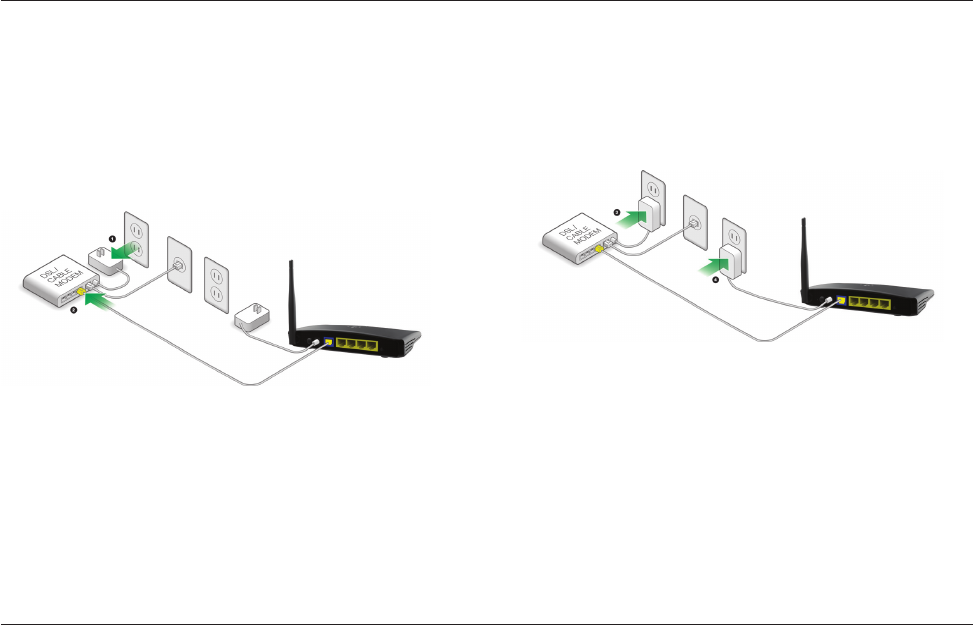
2
GETTING STARTED
How to Set It UP
Connect Your N150 Router
1. Turn off your modem by disconnecting its power supply.
2. Connect your Router to your modem using the cable.
3. Power up your modem by plugging in its power supply.
4. Power up your Router by plugging in its power supply.

3
GETTING STARTED
Adding Computers to Your Network
Wireless devices such as computers, network printers, and gaming
systems can connect to your Router with a few simple steps.
Manual Setup
If you know what sort of Internet service you have, you might try a
manual setup. For this you will need a Wi-Fi-enabled smartphone,
tablet, or computer.
Wirelessly Connect to Your Router
The default network name and password are
printed on the foot of the Router.
Use your computer, tablet, or smartphone to connect to
the wireless network shown on the network ID card.
When requested, please enter the password
(security key) provided on the card.
Using the WPS Button
Start WPS Push Button Connection (WPS PBC) on your computer or
other Wi-Fi device that you would like to connect wirelessly to your
Router. Often there will be a button for this purpose in software that
came with the device, or a physical “WPS” button on the device itself.
Within two minutes, press the WPS button on your Router.
The WPS indicator will blink green while it listens for your Wi-Fi device.
Once a connection is established, the light will turn green for about 5
minutes and then go out. If a connection is not established, the light will
blink green for 30s. You may repeat the process to try again.
You can repeat this process for each WPS-enabled device you’d like to
add to your network.

4
GETTING STARTED
Manually Set Up Your Internet Connection
Use a browser to visit http://Router/. The Router homepage should
appear.
You can also try visiting http://192.168.2.1/.
The status of your Internet connection is shown in the upper right corner
of the Router homepage.
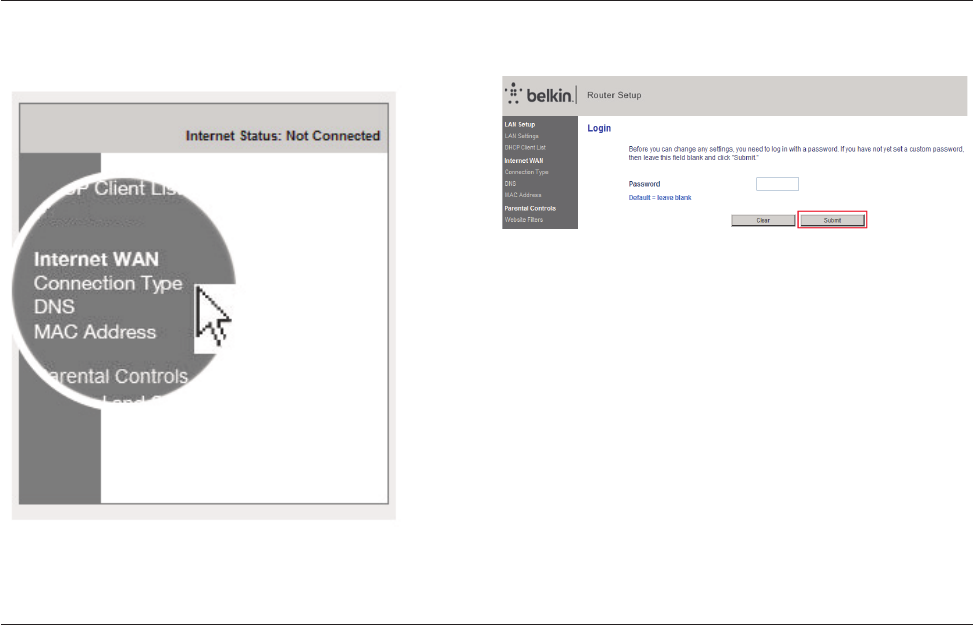
5
GETTING STARTED
If after a few moments it says “Connected”, you’re done! You can surf
the Internet.
If not, select “Connection Type” from the menu on the left.
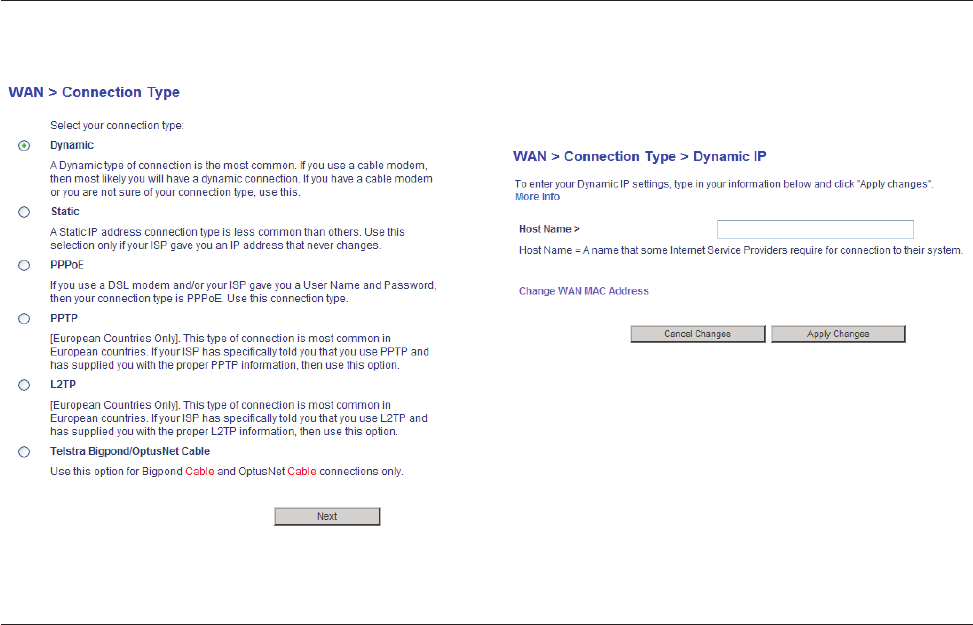
6
GETTING STARTED
If a password screen appears, press “Submit”. Dynamic Connection
Cable and fiber customers generally require a dynamic connection.
Some DSL customers require a PPPoE connection. Let’s try dynamic
first. Select “Dynamic” from the menu that appears and press “Next”.
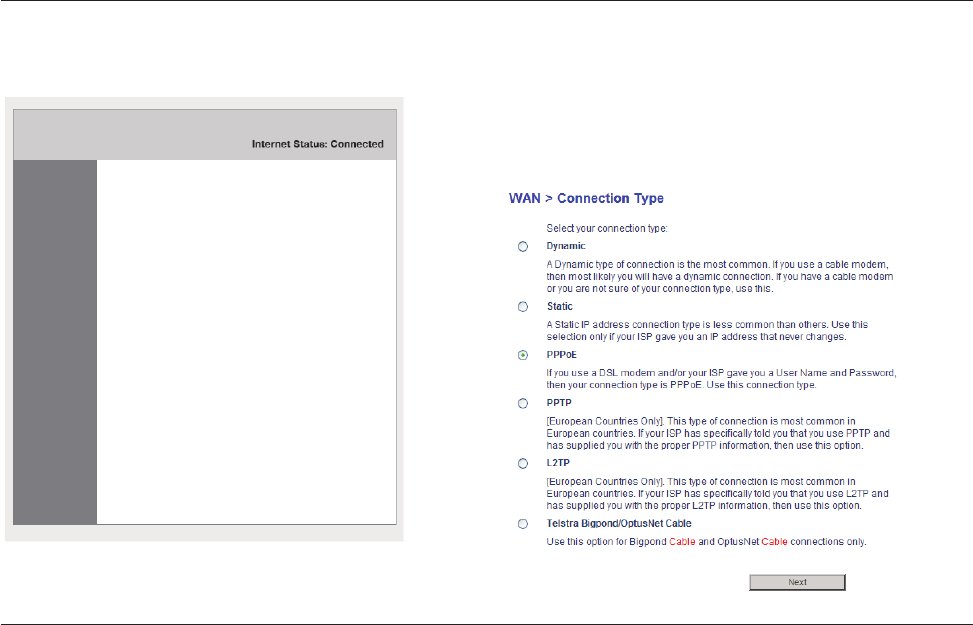
7
GETTING STARTED
Enter the host name provided by your Internet service provider. Click
“Apply Changes”.
If after a few minutes your Internet Status says “Connected”, you’re
done! You can surf the Internet.
If these steps do not work, try restarting your
modem and repeating the process.
If not, we’ll try a PPPoE connection next.
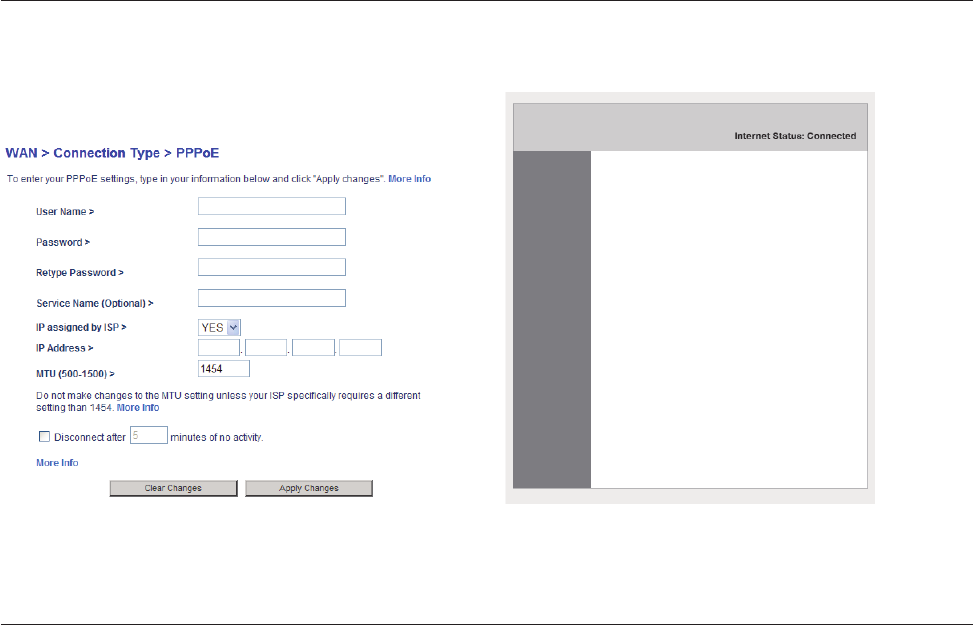
8
GETTING STARTED
PPPoE Connection
Some DSL customers require a PPPoE connection.
Select PPPoE this time and press “Next”.
Enter the username and password supplied by your Internet provider
and click “Apply Changes”. Ignore the other fields.
If after a few minutes your Internet Status says
“Connected”, you’re done! You can surf the Internet.
If these steps do not work, try restarting your
modem and repeating the process.

9
GETTING STARTED
Connecting Additional Devices
iOS
(iphone, iPad, and iPod touch)
Open the “Settings” app and select the “Wi-Fi” menu item.
Select your wireless network from the list that appears there. If asked to
do so, enter the network password.
Mac OS® X
Your Mac® provides a menu of available wireless networks at the right
end of the menu bar.
Click on the icon showing wireless waves.
Select your wireless network from the list that appears there. If asked to
do so, enter the network password.
Android
(phones and tablets)
Open the “Settings” app and select “Wireless” and “Network”.
From there, select “Wi-Fi” to see the list of available networks.
Select your wireless network from the list. If asked to do so, enter your
network password.
Windows® 7
Your computer provides a menu of available wireless networks at the
right end of the task bar.
Right-click on the icon that looks like signal strength bars.
Select your wireless network from the list. If asked, enter your network
password (network key).
Windows Vista® and Windows XP
Your device provides a menu of available wireless networks at the right
end of the task bar.
Right-click on the icon that shows a computer with wireless waves (XP)
or two computers (Windows Vista) .
Choose “View Available Wireless Networks” (XP) or “Connect to a
network” (Vista) from the menu.
Select your wireless network from the list. If asked, enter your network
password (network key).

GETTING TO KNOW YOUR ROUTER
10
Front Panel
Your Router’s status is shown by the lights on the front panel.
Power Light
Off: The Router is not plugged into a power source.
Solid Green: Power is supplied to the Router.
WLAN Light
Off: WLAN is disabled.
Blinking Green: Wireless data is being transmitted in the WLAN.
Solid Green: WLAN is enabled but no data transfer.
Wi-Fi Protected Setup (WPS) Light
Off: Idle
Blinking Green: The Router is listening for a WPS-
enabled computer or other device.
Successful Connection: The WPS light is SOLID GREEN for
5 minutes and then goes out when the Router has made a
secure connection with the computer or other device.
Failed Connection: The WPS light is BLINKING
GREEN for 30s after the WPS connection fails.
WAN Light
Off: WAN connection is not created.
Blinking Green: Data is being transmitted on the WAN port.
Solid Green: The Router is connected to the Internet.
LAN Light
Off: LAN connection is not created.
Blinking Green: Data is being transmitted on the LAN port.
Solid Green: The Router is connected to
devices through Ethernet cables.

GETTING TO KNOW YOUR ROUTER
11
Back Panel
Reset Button
This button is used to restore the factory default settings.
To reset the Router, press and hold this button for 8-10 seconds.
Power Connector
Connect the included power supply to this jack.
Modem (WAN) Connector
Connect your modem to this port using an Ethernet cable.
Wired (LAN) Connectors
Connect computers and other wired network device
to these ports using Ethernet cables.
WPS Button
The WPS button on the back of your Router can be used to help
establish a secure connection between your Router and other WPS-
enabled Wi-Fi devices such as computers. To use the WPS feature on
your Router, see “Getting Started > Adding Computers to Your Network
> Using the WPS Button”.

TECHNICAL DETAILS
12
Technical Features
Integrated 802.11n Wireless Access point
The N150 technology enhances your Router’s
wireless capabilities, allowing for data transfer speeds
of up to 150Mbps across your network.
NAT IP Address Sharing
To save you the cost of adding IP address per computer
in your house, our Belkin Router uses Network Address
Translation (NAT) technology, allowing you to share
a single IP address across your network.
SPI Firewall
Your Router is equipped with a firewall that will protect your
network from a wide array of common attacks and viruses.
Universal Plug-and-Play (UPnP) Compatibility
The UPnP (Universal Plug-and-Play) feature in your Router
offers seamless operation of voice and video messaging,
game, and other applications that are UPnP-compliant.
Web-Based Advanced User Interface
You can easily make changes to your Route’s advanced
settings through your web browser. These changes can
be made from any computer on your network.
Integrated 4-Port 10/100 Switch
Your Router has a built-in, 4-port network switch to
allow your wired computers to share: printers, data,
MP3 files, digital photos, and much more.
System Requirements
Router
Broadband Internet connection such as a cable or
DSL modem with RJ45 (Ethernet) connection
At least one computer with an installed network interface adapter
TCP/IP networking protocol installed on each computer
RJ45 Ethernet networking cable
Internet browser
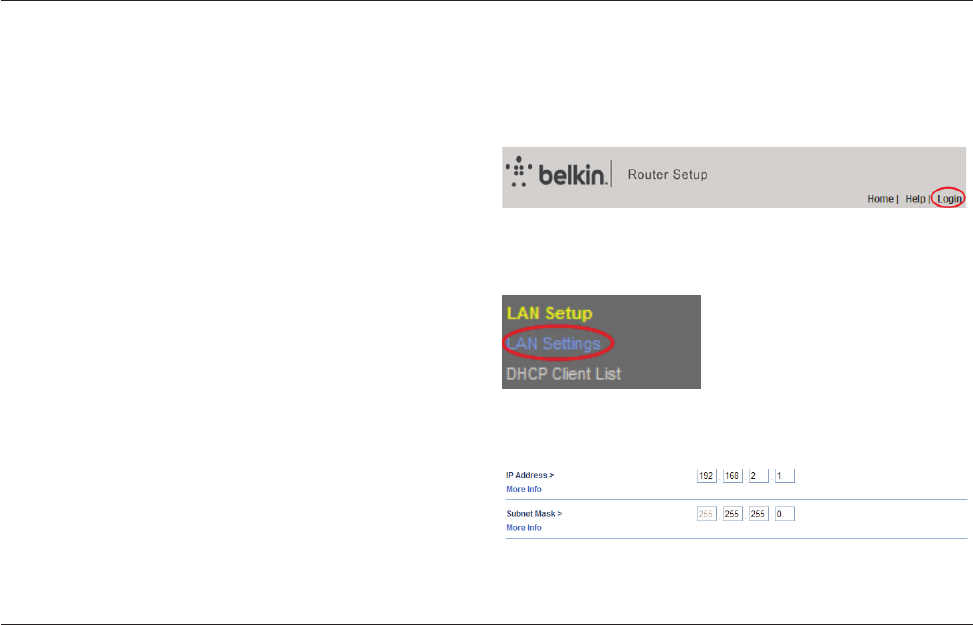
USING YOUR ROUTER
13
Using the LAN IP Setup
The “LAN Settings” page allows changing the
Router’s LAN IP address as required and configuring
Dynamic Host Configuration Protocol (DHCP).
Configuring Parameters of LAN IP Setup
LAN IP setup parameters are advanced settings that you may require
if you are a network administrator or your network requires a different
IP addressing scheme. The Router is shipped with the default IP
address on the LAN side and with the DHCP server enabled.
Note: If you change the default LAN IP address, you
must use the new LAN IP address to log in.
Setup steps:
Open a Web browser on the computer.
In the address bar of the Web browser, type http://192.168.2.1.
Click “Login” in the upper right corner of the page. The Router
does not ship with a password, so just click “Submit”.
Click on “LAN Settings” in the left column
under the “LAN Setup” heading.
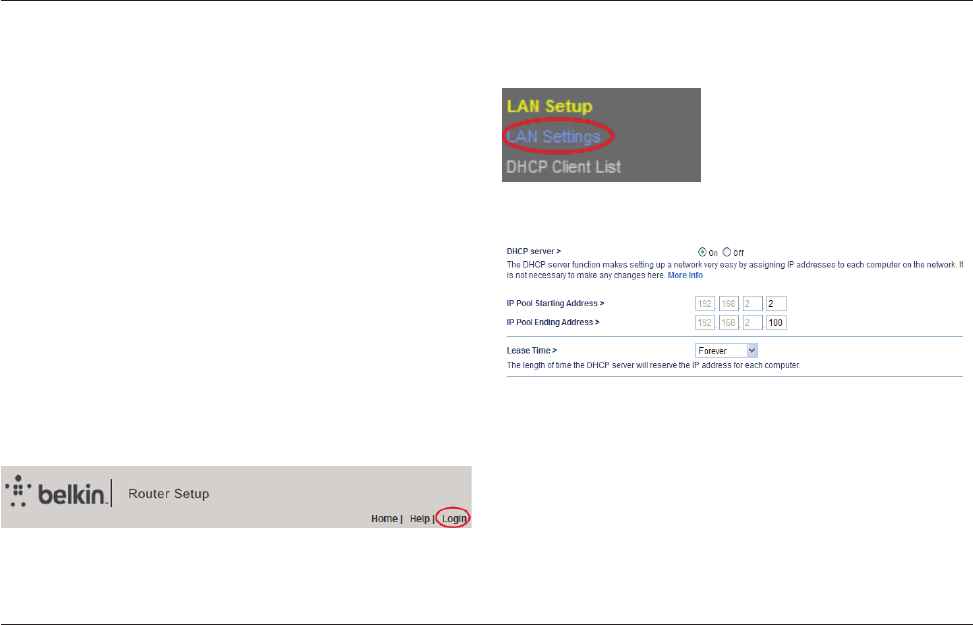
USING YOUR ROUTER
14
Configure the IP address and subnet mask.
IP Address: The IP address that a LAN user uses to
access the Router. The default IP is 192.168.2.1.
IP Subnet Mask: Subnet mask of the LAN port. You can enter a
different subnet mask according to the actual network status.
Click “Apply”.
Using the Router as a DHCP Server
By default, the Router acts as a DHCP server, automatically assigning
IP addresses to comupters in the LAN. Users do not need to configure
TCP/IP protocol paramters such as the IP address, the subnet mask,
the gateway, and the DNS server information for computers connected
to the Router’s LAN.
Setup steps:
Open a Web browser on the computer.
In the address bar of the Web browser, type http://192.168.2.1.
Click “Login” in the upper right corner of the page. The Router
does not ship with a password, so just click “Submit”.
Click on “LAN Settings” in the left column
under the “LAN Setup” heading.
Select the “On” button to use the Router as a DHCP server.
Configure the parameters below.
IP Pool Starting Address/IP Pool Ending Address: Set the starting and
ending IP addresses to specify a pool of IP addresses to be assigned
by the DHCP server. After you set “Starting IP Address/Ending IP
Address”, hosts in the LAN obtain IP addresses that are in the range of
the starting and ending IP addresses.
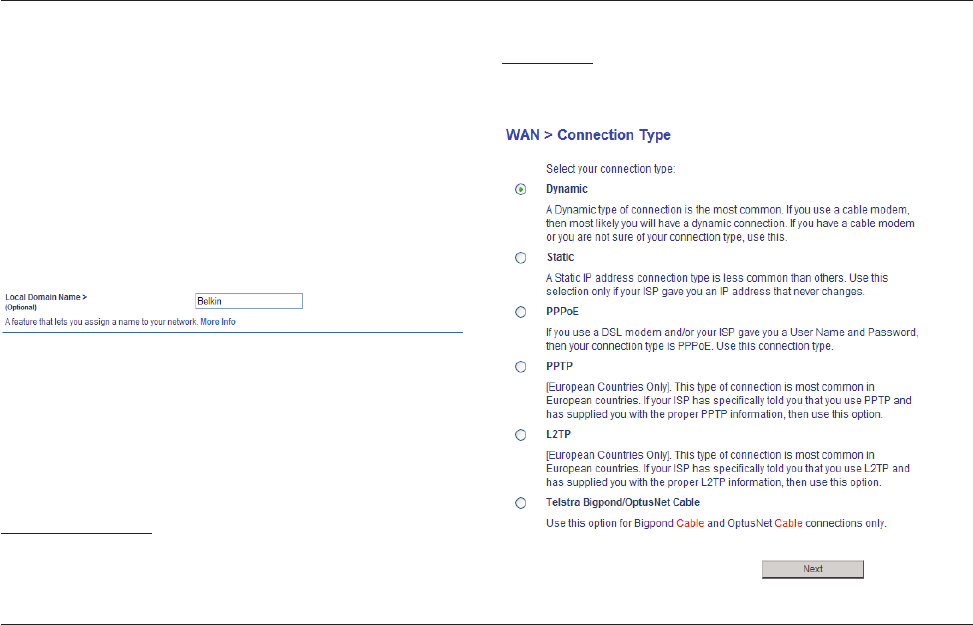
USING YOUR ROUTER
15
Lease Time: The valid time for an IP address that is automatically
assigned to a device by the DHCP server to a host. The DHCP server
does not assign the IP address to other hosts within the specified
time. If selecting “Forever”, you save devices in the LAN with fixed
addresses.
Configuring the Local Domain Name
The local domain name is a user-friendly name for your
Router. At the bottom of the “LAN Settings” page, you can
set a local domain name. The default name is Belkin.
There is no need to change this setting unless required.
Conguring Your Internet Connection
Settings related to your Internet service are specified in the “Connection
Type” page under the “Internet WAN” heading.
Select a WAN connection type. Contact your ISP if you do not know
your WAN connection mode.
Dynamic Connection
Cable and fiber customers generally require a dynamic connection.
Setup steps:
Click “Connection Type” in the left column
under the “Internet WAN” heading.
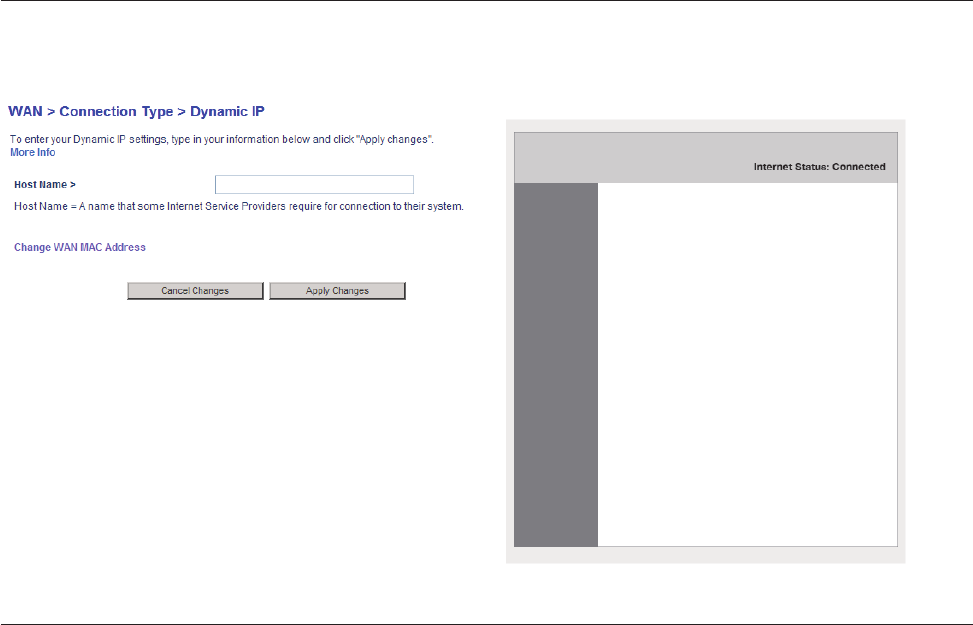
USING YOUR ROUTER
16
Select “Dynamic” in the “Connection Type”
page that appears. Click “Next”.
Enter the host name provided by your Internet provider.
Click “Apply Changes”.
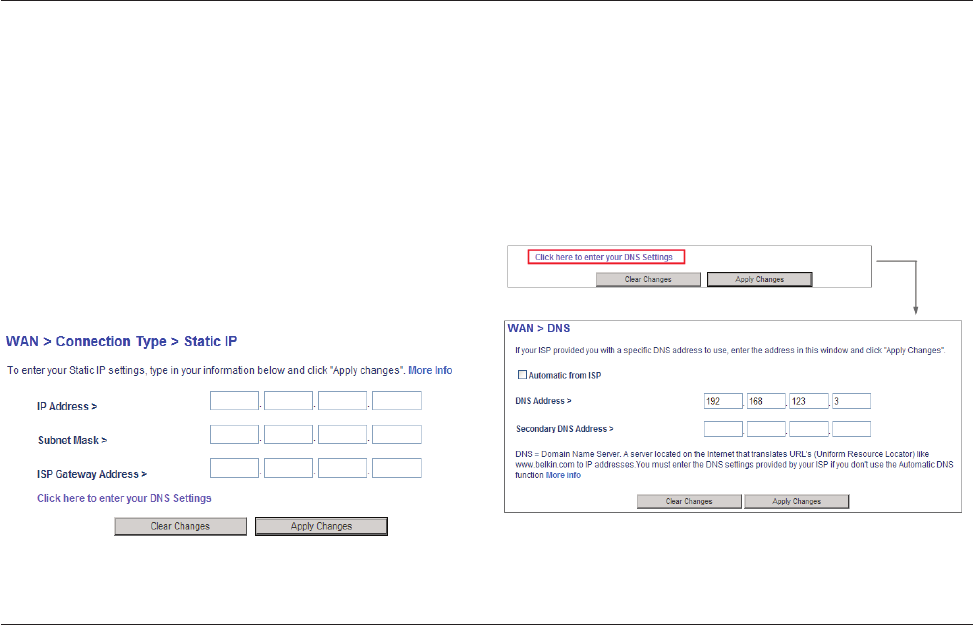
USING YOUR ROUTER
17
If after a few minutes your Internet Status says
“Connected”, you’re done! You can surf the Internet.
Static Connection
Select Static IP if your ISP provides the IP address, subnet
mask, and information about the gateway and DNS server.
Setup steps:
Click “Connection Type” in the left column
under the “Internet WAN” heading.
Select “Static” in the “Connection Type” page that appears.
Configure the parameters below. These parameters cannot be left
blank.
IP Address: Enter the WAN IP address provided by the ISP. The
parameter must be entered.
Subnet Mask: Enter the WAN subnet mask provided by the ISP. It varies
with the network type. It is usually 255.255.255.0 (Class C).
ISP Gateway Address: Enter the IP address of the gateway provided by
the ISP. It is the IP address used for connecting to the ISP.
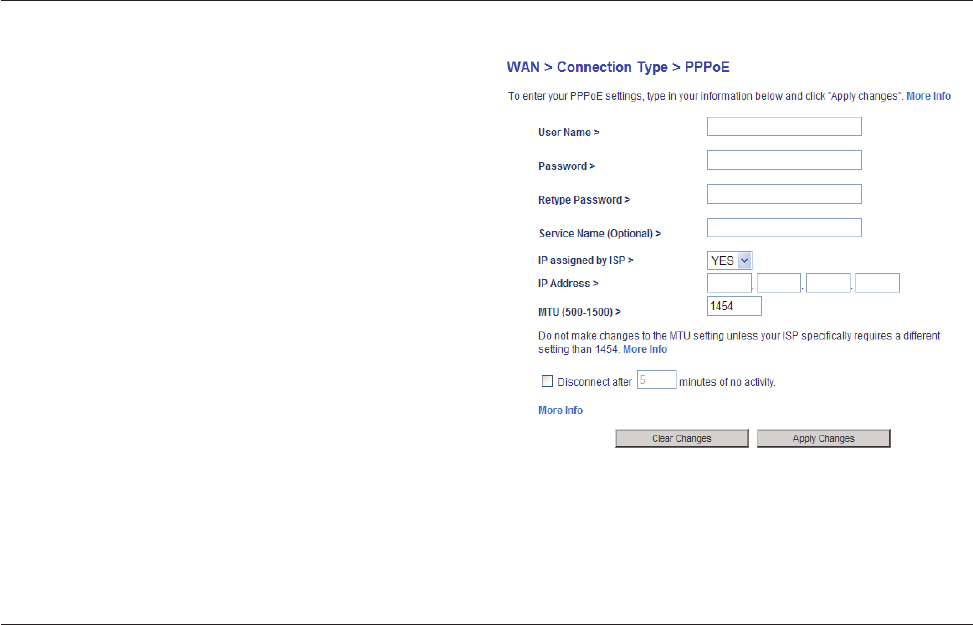
USING YOUR ROUTER
18
Click “Click here to enter your DNS Settings” to configure DNS
information.
Clear the “Automatic from ISP” check box.
In the “DNS Address” and “Secondary DNS Address” fields, enter the
IP addresses of the primary DNS server and the secondary server (if
available). At least enter one DNS server IP address.
Click “Apply Changes”.
If after a few minutes your Internet Status says “Connected”, you’re
done! You can surf the Internet.
PPPoE Connection
Most DSL providers use PPPoE (Point-to-Point Protocol over Ethernet)
as the connection type. If you use a DSL modem to connect to the
Internet, your ISP may use PPPoE to log you into the service.
Setup steps:
Click “Connection Type” in the left column
under the “Internet WAN” heading.
Select “PPPoE” in the “Connection Type” page that appears.
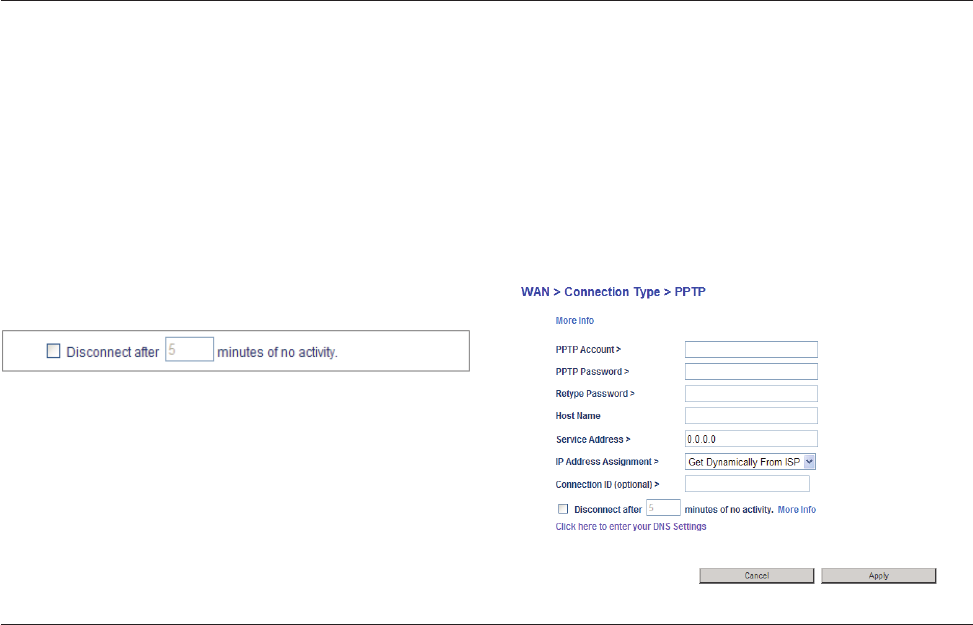
USING YOUR ROUTER
19
Configure the parameters below.
User Name and Password: Enter the user name and password provided
by the ISP. The user name and password are used to log in to the ISP
server.
Retype Password: Enter the password again.
Service Name: If several PPPoE servers are available, specify which
server to use.
IP assigned by ISP: You can select either to an IP address assigned
by your ISP, or to manually set an IP address in the “IP Address” field.
MTU: The maximum transmission unit. We strongly recommend you
to use the default setting unless your ISP gives you a specific MTU
setting.
If you select the “Disconnect after xxx minutes of no activity” check
box and specify a time interval, the system interrupts the Internet
connection when there is no Internet access behavior within the
specified time.
Click “Apply Changes”.
If after a few minutes your Internet Status says “Connected”, you’re
done! You can surf the Internet.
PPTP/L2TP Connection
Some ISPs require a connection using the PPTP or L2TP protocol.
Enter the account and password provided by your ISP.
The following takes PPTP connection as an example.
Setup steps:
Click “Connection Type” in the left column
under the “Internet WAN” heading.
Select “PPTP” in the “Connection Type” page that appears.
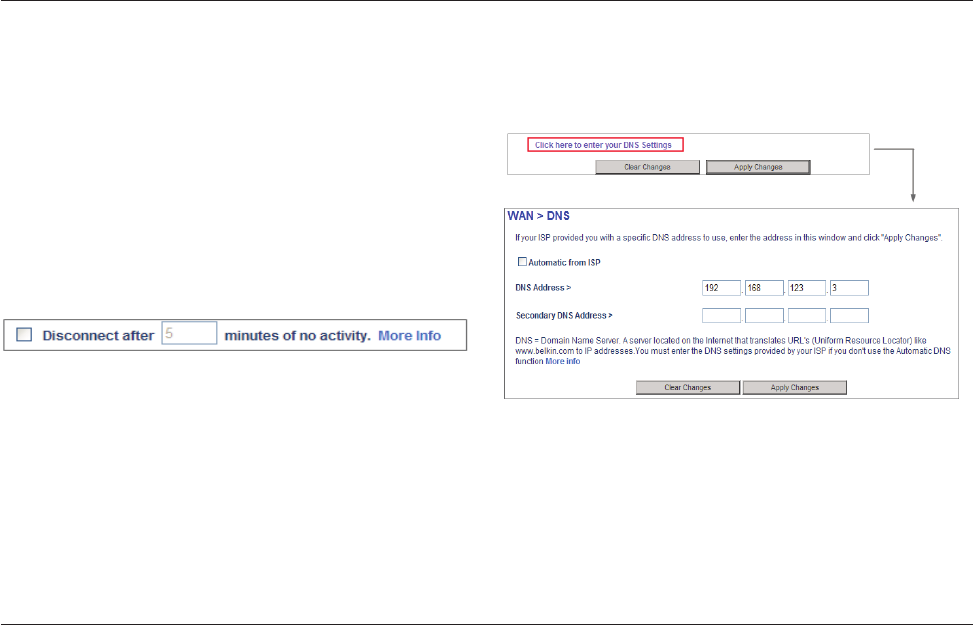
USING YOUR ROUTER
20
Configure the parameters below.
PPTP Account and PPTP Password: Enter the PPTP account and
password provided by the ISP. The PPTP account and password are
used to log in to the ISP server.
Retype Password: Enter the password again.
Host Name: (Optional) Enter the host name.
Service Address: Enter the IP address of the ISP server.
IP Address Assignment: You can select either to dynamically get an IP
address from the ISP or to use a static IP address. If you select “Use
Static IP Address”, manually enter the IP address, the subnet mask, and
the default gateway.
If you select the “Disconnect after xxx minutes of no
activity” check box and specify a time interval, the system
interrupts the Internet connection when there is no
Internet access behavior within the specified time.